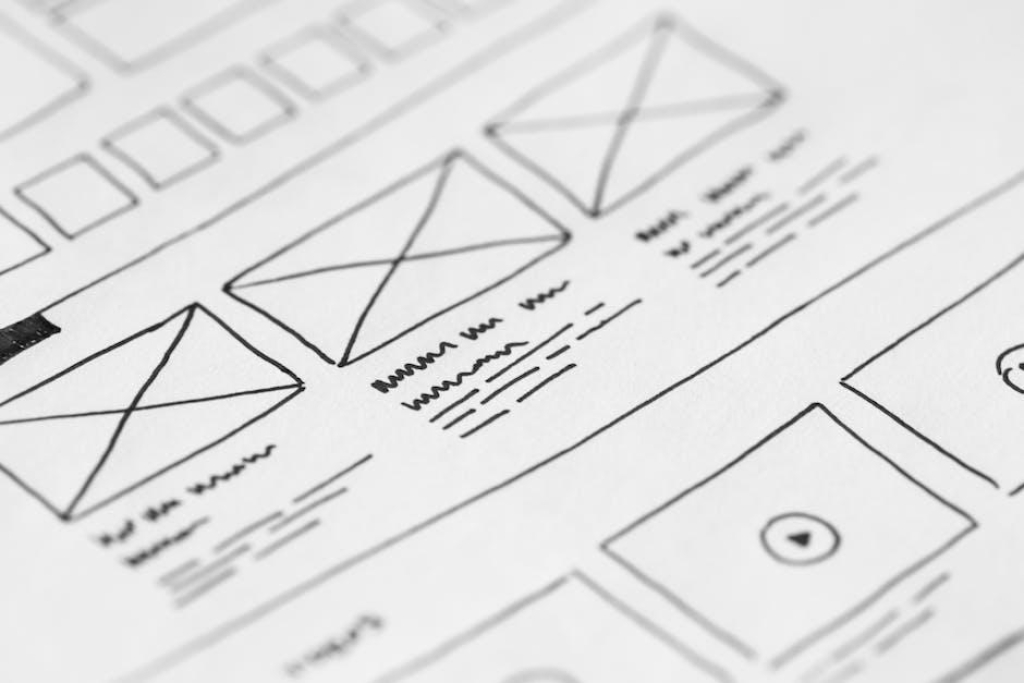In the digital age, a strong online presence has become an indispensable aspect of building a successful brand. And at the heart of this online presence lies web design – the crucial link that connects a brand’s identity with its target audience. From colors and typography to layout and user experience, web design plays a pivotal role in shaping a brand’s image and perception. In this article, we delve into the undeniable impact of web design on branding, exploring how it can elevate brand identity, enhance user engagement, and ultimately drive business success. So, join us as we uncover the critical role of web design in fostering a powerful and cohesive brand experience.

Table of Contents
Toggle1. The Significance of Web Design in Branding: Creating a Lasting Impression
When it comes to building a successful brand, web design plays a crucial role in creating a lasting impression on your audience. In today’s digital era, where the majority of interactions occur online, a well-designed website is the virtual face of your brand. It serves as a powerful tool to engage, captivate, and convert visitors into loyal customers.
Effective web design goes beyond aesthetics; it encompasses a strategic approach that combines visual elements, user experience, and branding. A professionally designed website not only elevates your brand’s credibility but also reflects your business’s vision, values, and unique personality. By delivering a seamless and visually appealing user experience, your website encourages visitors to stay longer, explore more, and ultimately convert into paying customers. With attention to detail and a user-centric design, your website becomes a powerful instrument for boosting brand awareness, recognition, and loyalty.
2. Unveiling the Power of Web Design: Elevating Brand Identity in the Digital Age
In today’s digital age, where online presence often defines a brand’s success, the power of web design cannot be underestimated. A well-designed website can create a lasting impression on visitors, conveying a sense of professionalism and trustworthiness. It serves as a virtual storefront, making it crucial for businesses to invest in an exceptional web design that elevates their brand identity.
First and foremost, web design allows companies to establish a cohesive brand identity across all digital platforms. Through consistent color schemes, typography choices, and visual elements, a website can reflect the essence of a brand and leave a lasting impression on visitors. By incorporating brand logos, slogans, and even taglines strategically throughout the site, businesses can reinforce their brand’s voice and messaging. A visually appealing and easy-to-navigate website not only captivates visitors but also reinforces brand recognition, fostering a sense of trust and familiarity.
In addition to enhancing brand identity, effective web design also improves user experience. A thoughtfully designed website considers user behavior and aims to provide a seamless browsing experience. This means optimizing loading times, creating a responsive design that adapts to different screen sizes, and ensuring intuitive navigation. By focusing on user experience, businesses can increase customer engagement, improve conversion rates, and ultimately drive business growth. A visually stunning website is not enough; it must also prioritize functionality to provide a delightful experience for visitors. With the power of web design, businesses can unlock the full potential of their brand identity and make a lasting impact in the digital landscape.
3. A Closer Look at Web Design’s Role in Shaping Brand Perception
In today’s digital age, a well-designed website is more than just a necessary extension for businesses. It has become a powerful tool in shaping brand perception and ultimately influencing customer behavior. Web design plays a crucial role in capturing and reflecting the essence of a brand, creating a lasting impact on visitors’ minds.
One key element of web design that affects brand perception is visual appeal. A visually appealing website instantly grabs the attention of visitors, instilling a sense of credibility and professionalism. Thoughtful color schemes, striking imagery, and clean typography all contribute to creating a positive first impression. By using bold and vibrant colors that align with the brand identity, businesses can effectively convey their personality and evoke specific emotions. Additionally, integrating high-quality visuals, such as product images or videos, into the website can further enhance the brand perception and engage users.
Besides aesthetics, user experience design (UX) plays a pivotal role in shaping brand perception. A user-friendly website that prioritizes seamless navigation and intuitive interfaces not only enhances the overall user experience but also improves the credibility of the brand. By ensuring that information is accessible with minimal effort, businesses can instill a sense of trust and reliability in their audience. Incorporating clear call-to-actions and strategically placing them throughout the website can also influence user behavior, driving conversions and increasing customer satisfaction. In today’s fast-paced world, where users have limited attention spans, a well-designed, responsive website that provides a seamless browsing experience has the power to captivate and retain customers, ultimately shaping brand perception positively.
4. Harnessing the Potential of Web Design: Strategies for Building a Strong Brand Online
In today’s digital era, web design has become a crucial aspect of building a strong brand presence online. A well-designed website not only captures the attention of your target audience but also conveys the essence and values of your brand effectively. Here are some strategies to harness the potential of web design and establish a remarkable online brand presence.
1. Define your brand identity: Before diving into the visual aspects of web design, it’s essential to have a clear understanding of your brand’s identity. Start by identifying your target audience, unique selling points, and brand values. Use this information as a foundation to create a website that reflects your brand’s personality and resonates with your target market.
2. Prioritize user experience: A visually appealing website is meaningless if it fails to provide an exceptional user experience. Ensure that your website is easy to navigate, responsive on different devices, and loads quickly. Intuitive navigation, clear calls-to-action, and well-organized content will engage visitors and encourage them to explore further. Create a seamless browsing experience by optimizing your website’s performance and implementing user-friendly features such as live chat support or FAQs.
3. Implement a cohesive visual design: Consistency is key when it comes to web design. Utilize consistent color schemes, typography, and imagery throughout your website to establish a strong visual identity. Incorporate your brand logo, typography, and color palette into the design elements to create a cohesive and recognizable brand presence. Additionally, consider the overall layout and structure of your website, ensuring it aligns with your brand aesthetic and allows for an easy flow of information.
4. Leverage compelling content: Compelling and engaging content is a vital component of building a strong brand online. Use persuasive copywriting techniques to tell your brand’s story effectively and connect with your target audience on an emotional level. Incorporate relevant keywords strategically to improve SEO and drive organic traffic to your website. Include captivating images, videos, and interactive elements to enhance user engagement.
5. Optimize for mobile devices: With the increasing use of smartphones, having a mobile-friendly website is no longer an option but a necessity. Ensure that your website is responsive and adapts seamlessly to different screen sizes. Mobile optimization not only improves user experience but also boosts your website’s search engine rankings.
Harnessing the potential of web design is essential for building a strong brand online. By following these strategies, you can create a visually captivating and user-friendly website that effectively communicates your brand’s values and captivates your target audience. Remember, a well-designed website is the gateway to establishing a solid online brand presence and driving significant business growth.
5. Beyond Aesthetics: How Web Design Elements Impact Brand Recognition and Trust
In today’s digital age, web design elements hold a significant influence on how a brand is perceived and trusted by its audience. Beyond simply focusing on aesthetics, a well-designed website can establish credibility, build recognition, and foster trust. Let’s explore some key web design elements that play a pivotal role in shaping brand perception and trust.
1. Color Palette: Colors evoke emotions and associations, making them a powerful tool for brand recognition. Consistency in using a brand’s color palette across the website helps create a sense of familiarity and brand identity. Utilizing contrasting colors to highlight important elements and visually guide the user can also enhance the overall user experience.
2. Typography: A carefully selected typography can convey professionalism, uniqueness, and brand personality. Choosing fonts that align with the brand identity establishes a cohesive visual language. It is crucial to consider factors such as legibility, readability, and appropriate font pairings to ensure a pleasant reading experience.
3. Visual Consistency: Maintaining visual consistency across all pages of a website promotes brand recognition and professionalism. Consistent use of imagery, icons, and design patterns reinforces the brand’s visual identity. Moreover, incorporating the brand logo strategically, such as in the header or footer, helps establish a sense of trust and legitimacy.
4. Navigation: Intuitive and user-friendly navigation is a vital element in building trust. A well-structured menu, clear call-to-action buttons, and easy access to important information ensure that users can effortlessly find what they are looking for. A smooth and efficient navigation experience creates a positive impression, enhancing brand recognition and trustworthiness.
It is crucial for businesses to recognize the impact of web design elements beyond mere aesthetics. Implementing thoughtful design choices can have a profound effect on brand recognition and the trust that users place in a website. By leveraging colors, typography, visual consistency, and intuitive navigation, brands can establish a strong online presence that resonates with their target audience, ultimately driving higher engagement and customer loyalty.
Q&A
Q: How does web design impact branding?
A: Web design plays a crucial role in shaping a company’s brand identity online. It represents the visual elements, usability, and overall user experience of a website, which directly affects how visitors perceive and connect with a brand.
Q: What are the key factors of web design that impact branding?
A: Several factors contribute to the impact of web design on branding. These include color schemes, typography, imagery, layout, navigation, and responsiveness. Each element should align with the brand’s values, messaging, and target audience to create a cohesive and compelling online presence.
Q: How does the choice of colors and typography influence branding?
A: Colors and typography evoke emotions and help create a distinctive brand identity. The right color palette and fonts will convey the brand’s personality, align with its industry, and attract the intended audience. Consistency in their application across the website reinforces brand recognition and helps in building trust and familiarity with the brand.
Q: How does imagery affect branding in web design?
A: Imagery, including photos, illustrations, and graphics, plays a significant role in conveying a brand’s message visually. The choice of images should reflect the brand’s values, resonate with its target audience, and enhance the overall user experience. Unique and high-quality visuals can captivate users, leave a lasting impression, and foster a sense of trust and professionalism.
Q: Why is intuitive navigation important for branding?
A: Intuitive navigation ensures that users can effortlessly find what they are looking for on a website. It impacts branding by providing a positive user experience, improving engagement, and reinforcing a brand’s credibility. Brands must organize their navigation menu logically and make it easily accessible across devices to enable users to explore and interact seamlessly.
Q: How does responsive design influence branding?
A: With the increasing use of mobile devices, responsive design has become critical for effective branding. A website that adapts its layout and design to different screen sizes ensures consistent user experiences across all devices. This flexibility showcases a brand’s commitment to accessibility, responsiveness, and professionalism, thus enhancing its overall brand image.
Q: What role does web design play in brand consistency?
A: Web design helps ensure brand consistency by incorporating consistent branding elements, such as colors, typography, imagery, and messaging, throughout the website. Consistency across different pages and platforms reinforces the brand identity, builds credibility, and creates a cohesive experience for users, leading to stronger brand recognition and customer loyalty.
Q: How can a well-designed website enhance brand trust and credibility?
A: A well-designed website exhibits professionalism, attention to detail, and a commitment to user experience. It instills confidence in visitors, demonstrating that the brand values their time and needs. A visually appealing, user-friendly, and easy-to-navigate website reflects positively on a brand’s reputation and establishes trust with both existing and potential customers.
Q: What are the potential consequences of poor web design on branding?
A: Poor web design can have detrimental effects on a brand’s image and reputation. If a website is visually unappealing, difficult to navigate, or lacks responsiveness, it can lead to a negative user experience and drive visitors away. Inconsistent branding elements can create confusion or mistrust, damaging the overall brand perception and potentially resulting in lost opportunities for sales or conversions.
Q: What are the key takeaways regarding the impact of web design on branding?
A: Web design is a fundamental element in shaping a brand’s online presence and overall perception. Attention to detail, consistency, and user experience are paramount to creating a positive and memorable brand identity. By investing in effective web design, companies can enhance user engagement, foster trust and credibility, and ultimately drive business success. In conclusion, it is evident that web design plays a pivotal role in shaping a brand’s identity and success in the digital era. Through careful consideration of visual elements, user experience, and consistent branding, businesses can effectively communicate their values and establish a strong online presence.
By understanding the importance of web design as a crucial link to branding, companies can leverage this powerful tool to enhance customer engagement, drive conversions, and ultimately, foster brand loyalty. A well-designed website not only captivates visitors but also reflects the essence of the brand, laying the foundation for long-lasting relationships with customers.
As technology continues to advance and consumer preferences evolve, businesses must stay attuned to the rapidly changing digital landscape. It is vital to regularly assess and update web design to ensure it remains in alignment with evolving brand strategies and aspirations.
To achieve a truly impactful web design that resonates with your target audience, it is essential to collaborate with professional designers who possess a comprehensive understanding of both aesthetic principles and branding strategies. By harnessing the expertise of these creative minds, brands can effectively convey their unique story, evoke emotions, and leave a lasting impression.
In this digitally driven world, a well-crafted website is not just an optional enhancement but an indispensable asset for any brand. By recognizing the crucial link between web design and branding, businesses can unlock the key to building a powerful online presence that sets them apart from the competition.
So, let your brand’s story come alive through thoughtful and strategic web design, and watch as it becomes an invaluable conduit for connecting with your audience, forging meaningful relationships, and shaping the future success of your brand. Remember, in the digital realm, first impressions are everything, and web design has the power to make them count.




